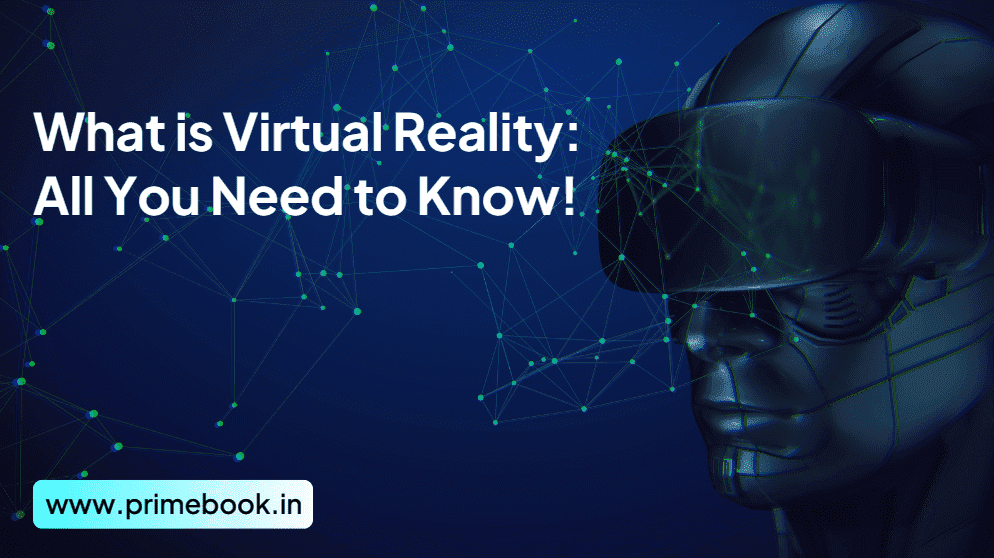Blogs / Educational Bytes / What is Virtual Reality: All You Need to Know!
Blogs / Educational Bytes / What is Virtual Reality: All You Need to Know!

Ananya Dasgupta
24 Apr 2024

What is Virtual Reality: All You Need to Know!
Table of Contents
In 1987, Jaron Lanier was the one to coin the term “virtual reality”. Today, in the post-pandemic era, it remains in the word of the mouth because of the robust transformation it brought to the field of science and technology. But what is this sci-fi innovation; what is virtual reality exactly? You may want to know! If so, this blog shall give you a thorough insight!
What Does Virtual Reality Mean?
Virtual reality, or VR, is the simulated virtual environment generated by computing technology, where you can enjoy a realistic virtual experience similar to your real life. It gives you an immersive feel by replacing your immediate external vision with interactive 3D visuals and sounds. While engaging in such an environment, you would have the sensation of being in an alternative world like you find in science fiction. The most prominent examples of virtual reality are video games, 3D animation movies, and dark rides in amusement parks.
How Does Virtual Reality Work?
In virtual reality, you are completely isolated from your physical surroundings and controlled by the computing system when experiencing it. Robust software and hardware are involved herein to give you an immersive and interactive experience. Devices like VR headsets, VR goggles, VR gloves, VR body suits, VR helmets, and more are used to send and receive information to and from the computer. There are motion sensors that track your movements and accordingly create the screen view in real-time.
By doing so, virtual reality tends to enhance the functional reality for you on the computer screen. So, whether you desire to go to Mars, visit the Roman Civilization from the past, or swim with dolphins and sea horses in the middle of the Pacific Ocean, virtual reality can help you do so from the comfort of your home. There are limitless applications of virtual reality, and it’s increasingly being leveraged to offer innovative experiences to users. Not just entertainment and gaming; this also goes for education, retail and native marketing, healthcare and wellness, travel and tourism, and so forth.
Also Read: Top Virtual Reality Industry Trends in 2024
What Are the Benefits of Virtual Reality?
Here are some of the significant benefits of virtual reality, paving for the advancement of this world across every horizon.
1. Students who cannot afford to go on field trips can now go for virtual field trips using this technology. They can conduct science experiments virtually without being exposed to risky materials. They can study from the digital replica of the book-based figures and objects and learn from 3D lectures.
2. Virtual reality enables you to explore various travel destinations, check the available accommodations and commutes, and see the side scenes virtually before booking the tour.
3. Retail businesses can utilize virtual reality technology to train their employees virtually and save time for high-priority tasks during peak hours. On the other, customers can leverage virtual stores and marketplaces to check products and services before they buy them.
4. The medical service provider can use virtual reality to give professional training on surgeries through the virtual simulation of real surgery. For the treatment of serious and complex diseases, virtual consultation rooms can be used to bring international specialists together.
5. For those designing and prototyping new products, virtual reality can offer room for testing and modifications. As a result, companies can speed up their development process and cut on operational costs.
What Are the Different Types of Virtual Reality?
Based on the immersion level, technology used, and user experience, virtual reality is of three types. Here they go!
Non-immersive Virtual Reality
Non-immersive virtual reality is typically the one where the user can’t directly interact with the virtual environment but can control some characters and their activities within it. It’s the most common type of VR that exists in our everyday lives today.
Semi-immersive Virtual Reality
Semi-immersive virtual reality is a relatively new type, or precisely a hybrid, where the user can partially interact with the virtual environment. This means you can interact and immerse yourself in the 3D visuals but not feel any other physical sensations.
Fully-immersive Virtual Reality
Fully immersive virtual reality is the most advanced type, where a realistic simulation is generated, blurring the boundaries of the physical and virtual worlds. It can simulate almost all your senses, be it sound, sight, touch, taste, or smell.
For More: 3 Different Types of Virtual Reality
To wrap up, virtual reality is a constantly evolving domain and there’s much more to explore in this field. As Chris Milk, the CEO of Within says, “Virtual reality is the ultimate empathy machine” having the power to reconfigure the ways we learn, train, or socialize. If utilized efficiently, virtual reality technology can indeed create a pathway for humans’ cultural and socio-economic development.


 Related Blog
Related Blog









